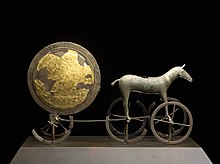
The archaeology of Northern Europe studies the prehistory of Scandinavia and the adjacent North European Plain, roughly corresponding to the territories of modern Sweden, Norway, Denmark, northern Germany, Poland and the Netherlands.
The region entered the Mesolithic around the 7th millennium BC. The transition to the Neolithic is characterized by the Funnelbeaker culture in the 4th millennium BC. The Chalcolithic is marked by the arrival of the Corded Ware culture, possibly the first influence in the region of Indo-European expansion. The Nordic Bronze Age proper began roughly one millennium later, around 1500 BC. The end of the Bronze Age is characterized by cultural contact with the Central European La Tène culture (Celts), contributing to the development of the Iron Age by the 4th century BC, presumably the locus of Common Germanic culture. Northern Europe enters the protohistorical period in the early centuries AD, with the adoption of writing and ethnographic accounts by Roman authors.
© MMXXIII Rich X Search. We shall prevail. All rights reserved. Rich X Search
